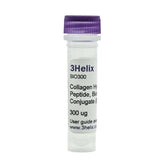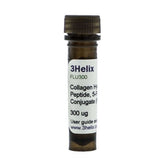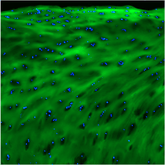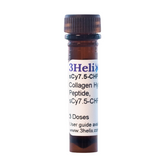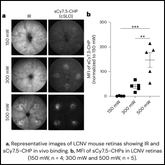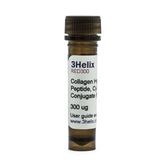Collagen Hybridizing Peptide Detects Excess Collagen Degradation in Periodontal Ehlers-Danlos Syndrome Fibroblasts
Ehlers-Danlos syndrome (EDS) is a cluster of connective tissue disorders with a range of manifestations across organ systems. Periodontal EDS (pEDS) is a form of EDS characterized by weakening tissue around the teeth, leading to fragile gums, gingival recession, and tooth loss. pEDS has been linked to heterozygous missense mutations in the genes...
View Details
First Empirical Evidence of Collagen Damage during Bone Fracture
Bone is a remarkable material, strong enough to withstand impressive forces without fracturing. Despite decades of research, however, our understanding of the molecular mechanisms underlying bone’s fracture resistance has remained incomplete. It has long been hypothesized that collagen degradation occurs following bone fracture. Until recently, this hypothesis lacked empirical evidence due to a...
View Details
Skeletal muscle fibrosis is associated with decreased muscle inflammation and weakness in patients with chronic kidney disease
Chronic kidney disease (CKD) progressively impairs kidney function, affecting millions. Beyond kidney-related complications, patients often experience muscle weakness and reduced mobility, begging the question: does muscle fibrosis contribute to those limitations? Figure 1 demonstrates a significant increase in collagen deposition within the vastus lateralis muscle of CKD patients. Histochemical analysis using picro-sirius red...
View Details
What happens when the eye’s protective armor comes under attack?
Collagen Hybridizing Peptides (CHPs) are revolutionizing the study of scleral inflammation. See how CHPs are used to visualize collagen degradation and uncover new insights into diseases like scleritis.
View Details
Cardiac Cell Therapy: Redefining the Path to Cardiac Repair
(b) Confocal micrographs of heart tissue sections from Ccr2-RFP × Cx3cr1-GFP mice 10 days post-ischemia-reperfusion (I–R) injury show the infarct border zone versus remote myocardium. A biotin-conjugated CHP, detected with a streptavidin-conjugated Alexa 647 secondary antibody (purple), visualized immature or denatured collagen, pinpointing areas of active ECM remodeling. Stem cell therapy has long been...
View Details
Antioxidant-loaded sEVs Boost Collagen Turnover in Atrophic Muscles
Antioxidant-loaded small extracellular vesicles (sEVs) enhance muscle regeneration and accelerate collagen turnover, offering a promising cell-free therapy for skeletal muscle atrophy. Using Collagen Hybridizing Peptides (CHPs), researchers quantified collagen remodeling and showed how sEVs stimulate recovery in atrophic muscles. Learn how this innovative approach combines antioxidant-loaded sEVs and CHPs to drive tissue repair and...
View Details
Using B-CHP to Stain for Damaged Collagen Illuminates Impacts of Retinal + Retinol Analog Treatment on UV Exposed Skin
UV light exposure causes skin damage, leading to wrinkles, roughness, and accelerated aging. While retinoids are effective anti-aging treatments, they often cause skin irritation. This study highlights a breakthrough alternative using retinal (RAL), combined with plant-derived retinol analogs like bakuchiol (BAK) and Vigna aconitifolia extract (VAE). Research on UV-damaged skin demonstrated that this combination...
View Details
Metformin Pre-Treatment Improves ECM Remodeling and Collagen Turnover, Highlighted by CHP Use in Muscle Fibrosis
Metformin pre-treatment enhances extracellular matrix (ECM) remodeling and reduces muscle fibrosis during bed rest, with critical insights provided by collagen hybridizing peptides (CHPs). By increasing type I myofiber size and decreasing cellular senescence markers, metformin promotes healthier muscle recovery and improves collagen turnover. This approach, supported by CHP technology, shows promise as an anti-inflammatory...
View Details
